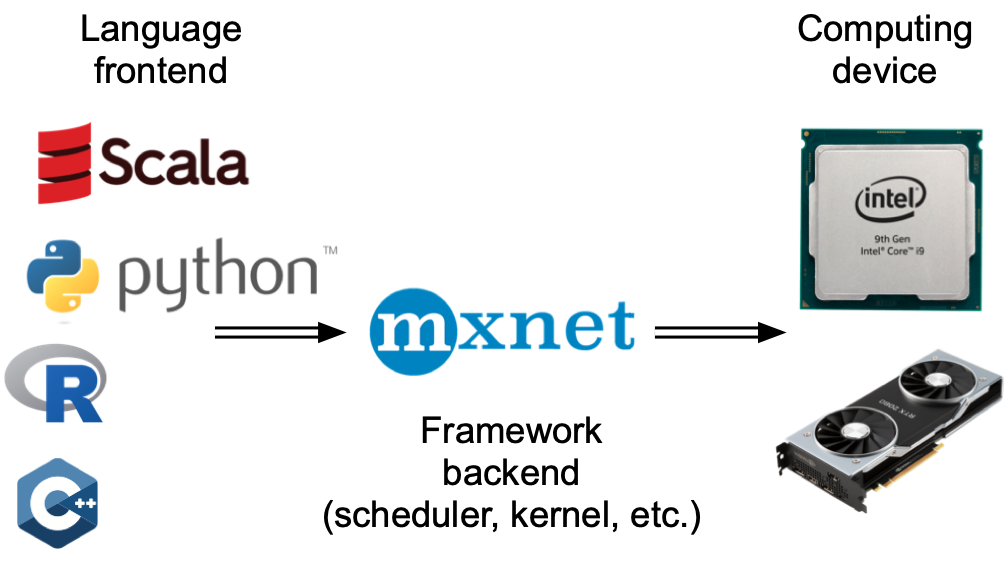为每个新模型从头开始实施并行性并不好玩。此外,优化同步工具以获得高性能有很大的好处。在下文中,我们将展示如何使用深度学习框架的高级 API 来执行此操作。数学和算法与第 13.5 节中的相同。毫不奇怪,您至少需要两个 GPU 才能运行本节的代码。
import torch from torch import nn from d2l import torch as d2l
from mxnet import autograd, gluon, init, np, npx from mxnet.gluon import nn from d2l import mxnet as d2l npx.set_np()
13.6.1。玩具网络
让我们使用一个比13.5 节中的 LeNet 更有意义的网络 ,它仍然足够容易和快速训练。我们选择了一个 ResNet-18 变体(He et al. , 2016)。由于输入图像很小,我们对其进行了轻微修改。特别地,与第 8.6 节的不同之处在于,我们在开始时使用了更小的卷积核、步长和填充。此外,我们删除了最大池化层。
#@save
def resnet18(num_classes, in_channels=1):
"""A slightly modified ResNet-18 model."""
def resnet_block(in_channels, out_channels, num_residuals,
first_block=False):
blk = []
for i in range(num_residuals):
if i == 0 and not first_block:
blk.append(d2l.Residual(out_channels, use_1x1conv=True,
strides=2))
else:
blk.append(d2l.Residual(out_channels))
return nn.Sequential(*blk)
# This model uses a smaller convolution kernel, stride, and padding and
# removes the max-pooling layer
net = nn.Sequential(
nn.Conv2d(in_channels, 64, kernel_size=3, stride=1, padding=1),
nn.BatchNorm2d(64),
nn.ReLU())
net.add_module("resnet_block1", resnet_block(64, 64, 2, first_block=True))
net.add_module("resnet_block2", resnet_block(64, 128, 2))
net.add_module("resnet_block3", resnet_block(128, 256, 2))
net.add_module("resnet_block4", resnet_block(256, 512, 2))
net.add_module("global_avg_pool", nn.AdaptiveAvgPool2d((1,1)))
net.add_module("fc", nn.Sequential(nn.Flatten(),
nn.Linear(512, num_classes)))
return net
#@save
def resnet18(num_classes):
"""A slightly modified ResNet-18 model."""
def resnet_block(num_channels, num_residuals, first_block=False):
blk = nn.Sequential()
for i in range(num_residuals):
if i == 0 and not first_block:
blk.add(d2l.Residual(
num_channels, use_1x1conv=True, strides=2))
else:
blk.add(d2l.Residual(num_channels))
return blk
net = nn.Sequential()
# This model uses a smaller convolution kernel, stride, and padding and
# removes the max-pooling layer
net.add(nn.Conv2D(64, kernel_size=3, strides=1, padding=1),
nn.BatchNorm(), nn.Activation('relu'))
net.add(resnet_block(64, 2, first_block=True),
resnet_block(128, 2),
resnet_block(256, 2),
resnet_block(512, 2))
net.add(nn.GlobalAvgPool2D(), nn.Dense(num_classes))
return net
13.6.2。网络初始化
我们将在训练循环内初始化网络。有关初始化方法的复习,请参阅第 5.4 节。
net = resnet18(10) # Get a list of GPUs devices = d2l.try_all_gpus() # We will initialize the network inside the training loop
The initialize function allows us to initialize parameters on a device of our choice. For a refresher on initialization methods see Section 5.4. What is particularly convenient is that it also allows us to initialize the network on multiple devices simultaneously. Let’s try how this works in practice.
net = resnet18(10) # Get a list of GPUs devices = d2l.try_all_gpus() # Initialize all the parameters of the network net.initialize(init=init.Normal(sigma=0.01), ctx=devices)
Using the split_and_load function introduced in Section 13.5 we can divide a minibatch of data and copy portions to the list of devices provided by the devices variable. The network instance automatically uses the appropriate GPU to compute the value of the forward propagation. Here we generate 4 observations and split them over the GPUs.
x = np.random.uniform(size=(4, 1, 28, 28)) x_shards = gluon.utils.split_and_load(x, devices) net(x_shards[0]), net(x_shards[1])
[08:00:43] src/operator/nn/./cudnn/./cudnn_algoreg-inl.h:97: Running performance tests to find the best convolution algorithm, this can take a while... (set the environment variable MXNET_CUDNN_AUTOTUNE_DEFAULT to 0 to disable)
(array([[ 2.2610207e-06, 2.2045981e-06, -5.4046786e-06, 1.2869955e-06,
5.1373163e-06, -3.8297967e-06, 1.4339059e-07, 5.4683451e-06,
-2.8279192e-06, -3.9651104e-06],
[ 2.0698672e-06, 2.0084667e-06, -5.6382510e-06, 1.0498458e-06,
5.5506434e-06, -4.1065491e-06, 6.0830087e-07, 5.4521784e-06,
-3.7365021e-06, -4.1891640e-06]], ctx=gpu(0)),
array([[ 2.4629783e-06, 2.6015525e-06, -5.4362617e-06, 1.2938218e-06,
5.6387889e-06, -4.1360108e-06, 3.5758853e-07, 5.5125256e-06,
-3.1957325e-06, -4.2976326e-06],
[ 1.9431673e-06, 2.2600434e-06, -5.2698201e-06, 1.4807417e-06,
5.4830934e-06, -3.9678889e-06, 7.5751018e-08, 5.6764356e-06,
-3.2530229e-06, -4.0943951e-06]], ctx=gpu(1)))
Once data passes through the network, the corresponding parameters are initialized on the device the data passed through. This means that initialization happens on a per-device basis. Since we picked GPU 0 and GPU 1 for initialization, the network is initialized only there, and not on the CPU. In fact, the parameters do not even exist on the CPU. We can verify this by printing out the parameters and observing any errors that might arise.
weight = net[0].params.get('weight')
try:
weight.data()
except RuntimeError:
print('not initialized on cpu')
weight.data(devices[0])[0], weight.data(devices[1])[0]
not initialized on cpu
(array([[[ 0.01382882, -0.01183044, 0.01417865],
[-0.00319718, 0.00439528, 0.02562625],
[-0.00835081, 0.01387452, -0.01035946]]], ctx=gpu(0)),
array([[[ 0.01382882, -0.01183044, 0.01417865],
[-0.00319718, 0.00439528, 0.02562625],
[-0.00835081, 0.01387452, -0.01035946]]], ctx=gpu(1)))
Next, let’s replace the code to evaluate the accuracy by one that works in parallel across multiple devices. This serves as a replacement of the evaluate_accuracy_gpu function from Section 7.6. The main difference is that we split a minibatch before invoking the network. All else is essentially identical.
#@save
def evaluate_accuracy_gpus(net, data_iter, split_f=d2l.split_batch):
"""Compute the accuracy for a model on a dataset using multiple GPUs."""
# Query the list of devices
devices = list(net.collect_params().values())[0].list_ctx()
# No. of correct predictions, no. of predictions
metric = d2l.Accumulator(2)
for features, labels in data_iter:
X_shards, y_shards = split_f(features, labels, devices)
# Run in parallel
pred_shards = [net(X_shard) for X_shard in X_shards]
metric.add(sum(float(d2l.accuracy(pred_shard, y_shard)) for
pred_shard, y_shard in zip(
pred_shards, y_shards)), labels.size)
return metric[0] / metric[1]
13.6.3。训练
和以前一样,训练代码需要执行几个基本功能以实现高效并行:
需要在所有设备上初始化网络参数。
在迭代数据集时,小批量将被划分到所有设备上。
我们跨设备并行计算损失及其梯度。
最后,我们计算精度(再次并行)以报告网络的最终性能。训练例程与前面章节中的实现非常相似,只是我们需要拆分和聚合数据。
def train(net, num_gpus, batch_size, lr):
train_iter, test_iter = d2l.load_data_fashion_mnist(batch_size)
devices = [d2l.try_gpu(i) for i in range(num_gpus)]
def init_weights(module):
if type(module) in [nn.Linear, nn.Conv2d]:
nn.init.normal_(module.weight, std=0.01)
net.apply(init_weights)
# Set the model on multiple GPUs
net = nn.DataParallel(net, device_ids=devices)
trainer = torch.optim.SGD(net.parameters(), lr)
loss = nn.CrossEntropyLoss()
timer, num_epochs = d2l.Timer(), 10
animator = d2l.Animator('epoch', 'test acc', xlim=[1, num_epochs])
for epoch in range(num_epochs):
net.train()
timer.start()
for X, y in train_iter:
trainer.zero_grad()
X, y = X.to(devices[0]), y.to(devices[0])
l = loss(net(X), y)
l.backward()
trainer.step()
timer.stop()
animator.add(epoch + 1, (d2l.evaluate_accuracy_gpu(net, test_iter),))
print(f'test acc: {animator.Y[0][-1]:.2f}, {timer.avg():.1f} sec/epoch '
f'on {str(devices)}')
def train(num_gpus, batch_size, lr):
train_iter, test_iter = d2l.load_data_fashion_mnist(batch_size)
ctx = [d2l.try_gpu(i) for i in range(num_gpus)]
net.initialize(init=init.Normal(sigma=0.01), ctx=ctx, force_reinit=True)
trainer = gluon.Trainer(net.collect_params(), 'sgd',
{'learning_rate': lr})
loss = gluon.loss.SoftmaxCrossEntropyLoss()
timer, num_epochs = d2l.Timer(), 10
animator = d2l.Animator('epoch', 'test acc', xlim=[1, num_epochs])
for epoch in range(num_epochs):
timer.start()
for features, labels in train_iter:
X_shards, y_shards = d2l.split_batch(features, labels, ctx)
with autograd.record():
ls = [loss(net(X_shard), y_shard) for X_shard, y_shard
in zip(X_shards, y_shards)]
for l in ls:
l.backward()
trainer.step(batch_size)
npx.waitall()
timer.stop()
animator.add(epoch + 1, (evaluate_accuracy_gpus(net, test_iter),))
print(f'test acc: {animator.Y[0][-1]:.2f}, {timer.avg():.1f} sec/epoch '
f'on {str(ctx)}')
让我们看看这在实践中是如何工作的。作为热身,我们在单个 GPU 上训练网络。
train(net, num_gpus=1, batch_size=256, lr=0.1)
test acc: 0.90, 14.0 sec/epoch on [device(type='cuda', index=0)]
train(num_gpus=1, batch_size=256, lr=0.1)
test acc: 0.93, 14.3 sec/epoch on [gpu(0)]
接下来我们使用 2 个 GPU 进行训练。与 13.5 节中评估的 LeNet 相比,ResNet-18 的模型要复杂得多。这就是并行化显示其优势的地方。计算时间明显大于同步参数的时间。这提高了可伸缩性,因为并行化的开销不太相关。
train(net, num_gpus=2, batch_size=512, lr=0.2)
test acc: 0.89, 8.8 sec/epoch on [device(type='cuda', index=0), device(type='cuda', index=1)]
train(num_gpus=2, batch_size=512, lr=0.2)
test acc: 0.91, 14.2 sec/epoch on [gpu(0), gpu(1)]
13.6.4。概括
Gluon 通过提供上下文列表为跨多个设备的模型初始化提供原语。
在可以找到数据的设备上自动评估数据。
在尝试访问该设备上的参数之前,请注意初始化每个设备上的网络。否则你会遇到错误。
优化算法自动聚合多个 GPU。
13.6.5。练习
-
gpu
+关注
关注
28文章
4702浏览量
128708 -
pytorch
+关注
关注
2文章
803浏览量
13150
发布评论请先 登录
相关推荐
新手小白怎么学GPU云服务器跑深度学习?
如何往星光2板子里装pytorch?
pytorch模型转换需要注意的事项有哪些?
Pytorch 1.1.0,来了!

基于PyTorch的深度学习入门教程之DataParallel使用多GPU
PyTorch在哪些地方分配GPU内存
PyTorch教程-13.2. 异步计算





 PyTorch教程-13.6. 多个 GPU 的简洁实现
PyTorch教程-13.6. 多个 GPU 的简洁实现











评论